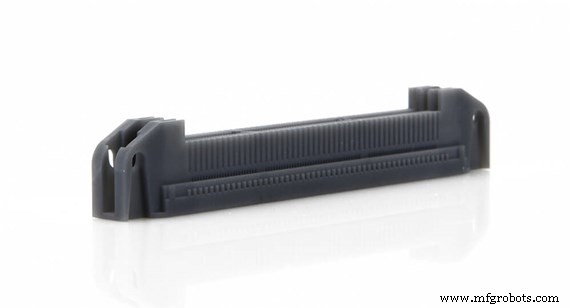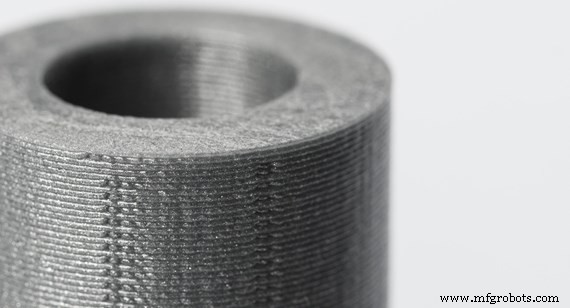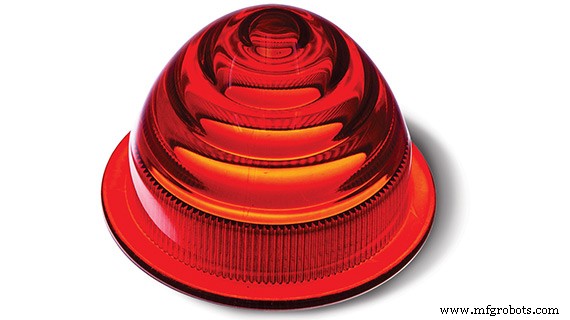SLA 与 FDM:比较常见的 3D 打印技术
增材制造,特别是现代 3D 打印,自 1983 年最初发展以来已经取得了长足的进步。今天的 3D 打印部件可以实现高分辨率和公差。两种更常见的技术是立体光刻 (SLA) 和熔融沉积建模 (FDM)。虽然两者都出现于 1980 年代,但它们使用截然不同的方式制造零件,因此,最终零件各自提供不同的好处。
 使用 Protolabs 的 MicroFine Gray™ 树脂制成的 SLA 部件可实现微精度分辨率。
使用 Protolabs 的 MicroFine Gray™ 树脂制成的 SLA 部件可实现微精度分辨率。 SLA 如何运作?
SLA 使用光敏聚合物树脂作为其零件的原材料。光聚合物需要来自激光的强烈紫外线才能凝固,这就是 SLA 背后的核心思想。构建发生在浸没在树脂中的平台上。激光位于水箱上方,在精密镜子的引导下,熔化液态树脂,使其硬化以达到所需的零件形状,一次一层。支撑结构是创建的第一层,可确保零件牢固地固定在平台上并得到充分支撑。每次通过时,重涂机刀片都会破坏部件上方树脂的表面张力。然后自下而上构建零件。
FDM 如何工作?
FDM 是最早的 3D 打印形式之一,由 Stratasys 的创始人之一 Scott Crump 发明。这个概念很简单——很像使用热胶枪。将热塑性长丝或塑料线轴加热至熔点。热的液态塑料通过喷嘴喷出,在构建平台上沿 X 轴和 Y 轴形成一层薄薄的单层。该层迅速冷却并硬化。随着每一层的完成,平台降低并沉积额外的熔融塑料,垂直生长部件(沿 Z 轴)。
SLA 和 FDM 的材料特性
| 进程 | 工作原理 | 强度 | 完成 | 常用材料 |
|---|---|---|---|---|
| SLA | 激光固化光聚合物 | 2,500-10,000 (psi) 17.2-68.9 (MPa) | 0.002-0.006 英寸(0.051-0.152 毫米)典型的附加层 | 类似于 ABS、PC 和 PP 的类热塑性光聚合物 |
| FDM | 融合挤压 | 5,200-9,800 (psi) 35.9-67.6 (MPa) | 0.005-0.013 英寸(0.127-0.330 毫米)典型的添加剂层 | ABS、PC、PC/ABS、PPSU、PEEK、ULTEM |
 在这个 FDM 部分,层线是可见的。照片:3Dhubs.com
在这个 FDM 部分,层线是可见的。照片:3Dhubs.com 例如,这两种技术都无法制造出与注塑成型零件一样坚固的零件,但它们适用于快速原型制作。 SLA’s thin layers and strong bonding between the layers makes its parts smoother, with minimal striations along the Z axis, the direction of the build.
SLA Considerations
If details and surface smoothness are important for your part, SLA handily beats FDM. In part, because of its roots in laser technology, SLA parts can offer incredibly fine detail, yet pricing is competitive. Also, the SLA ultraviolet light curing process avoids FDM’s issues caused by heat compressing previously drawn layers. Equally important, SLA offers many additional finishing options, such as dyeing and texturing.
With SLA, there are three resolution levels from which to choose, ranging from 0.004 in. (0.1016mm) to 0.001 in. (0.0254mm) for layer thickness. Choosing one over the other not only affects part quality, but manufacturing time, too. Minimum feature size can be as small as 0.0025 in. (0.0635mm) on the XY plane and 0.008 in. (0.2032mm) on the Z axis.
One important issue with SLA parts is their sensitivity to light. As photopolymers, they can degrade from exposure to UV rays, such as sunlight. Adding a protective coating can slow this process.
MicroFine™ is an exclusive Protolabs material available in gray and green. This micro-resolution, ABS-like material can print layers that are extremely thin:just 0.001 in. (0.0254mm). That kind of precision is a prerequisite for building parts with many small feature details and is regularly used for small and highly accurate medical components.
FDM Considerations
FDM uses engineering-grade materials (see chart above) and offers a range of color options. With some FDM printers, parts can be as large as 427 in. x 153 in. x 172 in. (10,845.8mm x 3,886.2mm x 4,368.8mm). Essentially it depends on the size of the build space. Also, FDM parts are moderately priced, making it ideal for hobbyists, dental offices, and classrooms.
FDM’s tolerance is dependent on how the machine is set up, but can be as small as +/-0.0035 in. (+/-0.0015mm). Layer thickness varies based on the material you’re using, and some printers can print as thin as 0.001 in. (0.0254mm), although this would lead to long print times and may not be possible with larger parts.
Because temperature affects the core material, FDM parts are subject to rippled exterior edges caused as new layers are dropped atop previous layers. These Z-axis issues also cause weakness in the build. So, a part’s strength is entirely dependent on the direction in which it was built.
FDM does not do well with wide, flat areas, and has difficulties printing sharp corners, so adding fillets to your design makes sense. For all these reasons, prototyping with FDM works well when accuracy and surface finish aren't critical.
Although FDM gets the check for cost, SLA is quite competitive, especially for cosmetic prototypes with intricate designs. It’s also a go-to process to create forms for injection molding and casting.
When to Use SLA and FDM
With all of these considerations in mind, here is a list of when to use either method.
Use SLA :
- For rapid, complex prototyping
- When precision and a smooth surface finish is important
- When high resolution, fine detail, and accuracy is necessary
- For creating molds for casting to facilitate mass production
- When strength and durability of the model is not crucial (models made from resin may suffer when exposed to the sun for long periods)
Use FDM :
- For prototyping
- When a selection of colors is needed
- For low-cost models
- When precision and surface finish aren’t crucial
- For hobbyist and maker projects

SLA produced this clear, red taillight with a smooth finish and custom post-production painting.
For additional help, feel free to contact a Protolabs applications engineer at 877-479-3680 or [email protected]. To get your next design project started today, simply upload a 3D CAD model for an interactive quote within hours.
工业技术


